| August 1937 Popular Mechanics |
 [Table of Contents] [Table of Contents]
Wax nostalgic about and learn from the history of early
mechanics and electronics. See articles from
Popular Mechanics,
published continuously since 1902. All copyrights hereby acknowledged.
|
The demise of Sears,
Roebuck and Co. is very disappointing to me. As with many Americans (and
Canadians) of my era and prior, I grew up with Sears being literally (in the
true sense of the word, not the faux usage like "I literally thought I would die
when she told me...") a household name. We had Kenmore kitchen appliances (some,
not all), clothes irons and hair blowers, and of course Craftsman tools and a
DieHard battery in the family sedan, Open Hearth wooden furniture, and some Toughskin clothes at the start of
the school year. We never, to my memory, had a Silvertone radio or record
player. It's not that the parents were Sears fanatics, just that our limited
budget mandated buying durable goods at a fair price. My own workshop is
dominated by Craftsman tools, many of which I have had for fifty years. Analysts
say poor management and a failure to embrace online sales were the primary
causes for ultimate doom. This "A City in a Store" article appearing in a 1937
issue of Popular Mechanics magazine highlights the catalog sales
business of Sears, along with the amazing conglomerate of operations supporting
both that and the brick and mortar retail sales locations. Just as
The Decline and Fall of the Roman Empire is a weighty,
multi-volume tome analyzing the human failings behind the tragedy, this
Smithsonian magazine article entitled
The Rise and Fall of Sears assesses the Sears debacle. The
conspiratorial side of me suspects globalist true believers are directing and
facilitating the breaking down of Western stalwart institutions in order to
erase history. The schools nowadays do not teach the accomplishments and heroic
parts of our past - only atrocities like slavery and child labor. Flooding the
country with aliens having no connection to our (or your) country's past helps
accomplish the goal. Anyway, read this and marvel at the ingenuity and
industriousness of Sears. Amazon was not the inventor of massive catalog
ordering and shipping.
Sears, Roebuck Mail Order Operations
 Most hidden cities have been dead for hundreds
of years. You know the kind in explorers' yarns that begin: "I stumbled over a stone,
pulled back the lush growth of jungle vines and there before us just as the Aztecs
left it was the hidden city." Most hidden cities have been dead for hundreds
of years. You know the kind in explorers' yarns that begin: "I stumbled over a stone,
pulled back the lush growth of jungle vines and there before us just as the Aztecs
left it was the hidden city."
Four miles west of Chicago's Loop is a different type of hidden city. It's a
bustling place confined within four blocks. Brick walls instead of jungle vines
hide it from the "explorers'" eyes. Life within this city reaches into every county
in every state in the nation. It is the home office and Chicago mail order division
of Sears, Roebuck & Co.
Many stories have been written about this gargantuan mail. order house, its catalogue,
its testing laboratories and the far-flung operations of the company's branches.
But the story of the self-sustaining "city" within the home plant has never been
told.
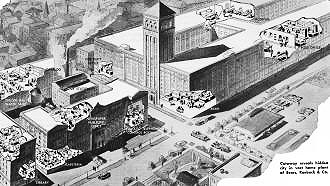
Cutaway reveals hidden city in vast home plant of Sears, Roebuck &
Co.
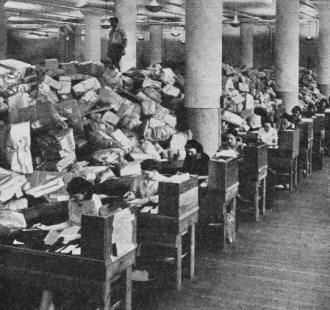
Life within "city" hums - here billers handle an avalanche of
40,000 parcels daily.
This city makes its own electricity and pumps water from its private well. (The
"population" of 9,500 requires 300 gallons of water every minute.) It has its own
fire department, watchmen and traffic cops, post office and telephone system. It
boasts a hospital, bank, newspaper, service station, park, subway, private bus,
retail store and restaurants.
If a rubberneck sight-seeing tour were conducted through the city, the first
stop might be at the fire department on the second floor of the big merchandising
building.
"We've got everything here but the fire engine," explains Fire Marshal E. J.
Kamin, "and that's in a little house by itself just around the corner."
The fire department not only guards "Searsville" day and night, but its "suburbs,"
the retail stores and warehouses scattered over the city of Chicago. Once Marshal
Kamin called the manager of a warehouse and asked about a fire in his basement before
the manager knew of the fire. This was possible because all Chicago fire alarms
are received in the marshal's office and are traced quickly with a card index system.
The office has an elaborate automatic signal system that records any disturbance
in the plant's sprinkler system. If the sprinkler heads in this system were placed
half a mile apart they would go around the world at the equator with 10,000 to spare.
In the plant they are placed eight feet apart. Several hundred alarm boxes are located
in the buildings and 10 men are constantly on patrol. There are 21 volunteer employee
fire companies. The members are trained with great care and each is instructed to
perform a specific duty at the sound of an alarm.
Aside from the fire engine and hundreds of feet of hose, the protective equipment
includes more than a thousand extinguishers and pumps.
"We're prepared for everything including failure of two sources of water supply,"
says Mr. Kamin. "If our own supply and the city supply fail us, we have three reserve
tanks that hold 190,000 gallons and a secondary surge tank of 250,000 gallons.
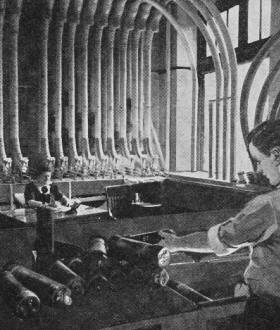
Nerve center of "city" - central station of pneumatic tube system
speeds carriers through miles of tubes.
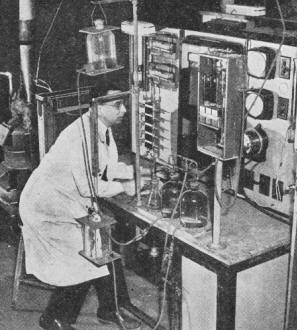
Testing hot water heater (in background) in Sears laboratory.
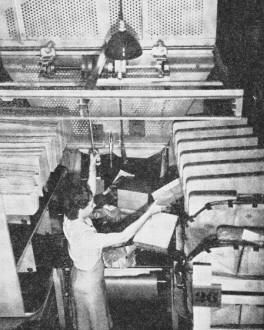
Wrapper pulls a cord 10 release packages sorted in "crow's nest"
above the chute
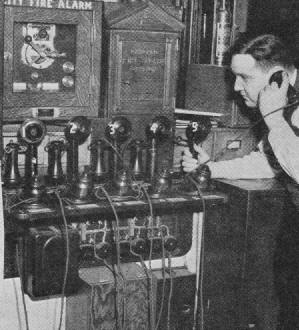
These "blackout" phones with red bulbs on base are used by fire
department to contact 13 air raid watch stations
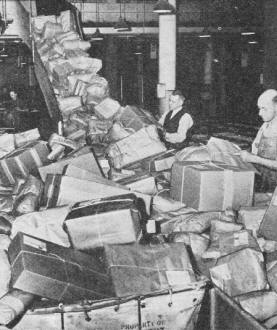
Packages pour down post office chute in never ending stream -
40,000 in normal day, 100,000 at peak season.
In case of an air raid, men are trained to man 13 special watch posts, including
roof stations. Each post is connected with the marshal's office by "blackout" telephones
separate from the company's private system. The blackout phones have red bulbs on
the base which light up when the bell rings. Alarms are located throughout the plant
to give a wavering note for warning and a steady ring for "all clear."
The marshal, who recently celebrated his 37th anniversary with the company, modestly
points out that the largest fire loss has been less than $2,000.
Near the fire marshal's office is the "police station" located conveniently near
the thriving Sears Community State Bank. Uniformed policemen, who serve primarily
as traffic cops, keep such a wary eye on the bank that no bandit has ever been tempted
to "do business" there. Incidentally, the bank is used by nearby residents as well
as Sears employees.
The next stop in the sight-seeing tour is the powerhouse. Its size, nearly half
a block long, never fails to amaze visiting engineers.
"Here's where we produce the heat, light, power and water," says Edward Buhrmester,
chief engineer, with a wave of his hand that takes in six whirring power generating
units, air compressors and pumps. "Until 1938 we generated all of our own electric
power. We still make 60 percent of it which amounts to more than a million kilowatt
hours a month."
Four of the power units are engine driven and two are driven by turbines. Steam
for the engines and turbines is considered "free" in winter, for it is also used
to heat the two main buildings and several smaller ones with a total floor space
of about 4,000,000 square feet.
Water is pumped by air pressure from a well 1,870 feet below. The well was drilled
in 1905 when the company, then 19 years old, moved to its present site.
"In those days there was just prairie and marsh land around here and no utilities
to speak of," says Edward J. Lempera, plant engineer. "They had quite a time drilling
the well. In one place they hit a crevice 100 feet deep, probably an underground
river. The water is fine for drinking. Its mineral content, however, is too high
for our boilers. We use city water in them."
The air compressors also supply the power for some five miles of pneumatic tubes
in the plant. Through these tubes 3,500 carriers make 96,000 trips a day.
Three huge pumping units operate accumulators weighing 50 tons each to supply
pressure for the institution's hydraulic elevators. They maintain a static pressure
of 800 pounds. Everything in the power house operates with precision, from the big
turbines to the electric eye in the chimney that warns of smoke density.
The hidden city tour winds through block-long corridors, past shelves loaded
with the 100,000 items of merchandise, past miles of conveyors piled with thousands
of packages, and into the shipping room. Here orders are assembled, wrapped and
started to the weighing room. Life within the city moves on a 15-minute schedule.
Some 1,900 orders (6,000 individual packages) bearing the same "time mark" must
move forward at each 15-minute interval to the next operation. The schedule system
is part of the reason the company can handle 100,000 orders received daily (in the
Chicago house only at the Christmas peak) and speed the merchandise on its way.
The Sears' employees, themselves, order 3,000 items daily that are delivered to
their desks.
Four times daily, in the busy shipping and weighing rooms music is heard through
a loud speaker system.
"They don't have to wait for the Saturday night band concert in our 'town',"
says Paul W. Briggs, manager of the shipping department. "Music relieves fatigue
and the workers love it. We use both radio and records. The music is on for half
hour periods the first thing in the morning, before lunch, early in the afternoon
and just before they go home."
Mr. Briggs says the packages really sail along to the tune of "Praise the Lord
and Pass the Ammunition," but he had to abandon "Deep in the Heart of Texas."
"They all stopped to clap their hands," he explains.
The Sears post office is one of the world's busiest. Pouches loaded with packages
move in an endless stream to the loading platform where they are then carried to
the mail trains. Canceled stamps are provided to save time. They are applied in
the weighing room and one day's supply costs $15,000 in a busy season.
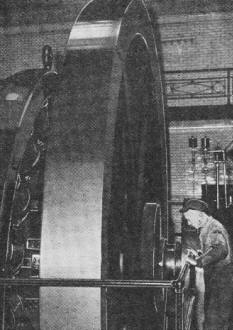
Giant wheel of power generating unit has been in use for 40 years
helping supply "homemade" electricity. Six units generate enough power to serve
a city of 60,000.
Sears' catalogue advertising department is a veritable publishing house that
turns out 15,000,000 catalogues annually, including summer and winter editions,
also produces 117 other sales publications. These include a semi-annual midseason
sales-book (17,000,000 copies); the "bargain bulletins" (26,000,000) and a special
Christmas supplement (6,000,000). Thousands of workers are employed in this publishing
enterprise, millions of dollars are spent and the product created is given away.
In return, some 11,000,000 customers order millions of dollars in merchandise in
a single year.
Another publishing activity is the city's newspaper, a tabloid called the Sears
News Graphic. It has its "local" staff, "foreign" correspondents (located in nine
mail order branches) and is circulated "nationally." It carries the news about employee
activities, special features, several columns and has an inquiring reporter department
and "letters from the people." Recently it has featured news about the more than
6,000 former Sears employees now working for Uncle Sam in the armed forces.
The two main buildings of the plant are connected by a subway for pedestrians.
A second subway, that few employees have ever seen, leads from the powerhouse and
extends under the merchandising building. This subway facilitates the servicing
of equipment and carries steam pipes, electric cables and pneumatic tubes.
On every executive's desk are two telephones, one for outside calls and the other
connected with the Sears system. The system has dial phones and an automatic control
room which handles 7,500,000 calls a year.
Scattered through the plant are various recreation rooms and across the street
from the administration building is the "city park." It has fountains, pools, benches
and is landscaped with beds of flowers.
This is about where the rubber-neck tour of the hidden city would end. Everyone
would rush to a bench and somebody would have out his pencil figuring how 9,500
persons could use up 300 gallons of water every minute.
Posted November 24, 2023
|










 Most hidden cities have been dead for hundreds
of years. You know the kind in explorers' yarns that begin: "I stumbled over a stone,
pulled back the lush growth of jungle vines and there before us just as the Aztecs
left it was the hidden city."
Most hidden cities have been dead for hundreds
of years. You know the kind in explorers' yarns that begin: "I stumbled over a stone,
pulled back the lush growth of jungle vines and there before us just as the Aztecs
left it was the hidden city." 







